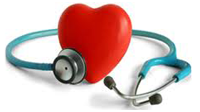Angina Pectoris
WHAT IS IT?
Angina pectoris, or angina, is a symptom of chest pain or pressure that occurs when the heart is not receiving enough blood and oxygen to meet its needs. Stable angina usually occurs in a predictable fashion during or after physical exercise or emotional stress.
Also Known As: Angina Pectoris, Stable, Chronic Stable Angina
Basic Facts
Angina pectoris, or angina, is a symptom of chest pain or pressure that occurs when the heart is not receiving enough blood and oxygen to meet its needs.
Angina results from coronary artery disease (CAD), which is an accumulation of plaque inside the coronary blood vessels.
There are two types of angina - stable and unstable.
Stable angina usually occurs in a predictable fashion during or after physical exercise or emotional stress.
Unstable angina occurs in unexpected or unpredictable times, such as at rest.
Unstable angina symptoms are a medical emergency, and may be a precursor for a heart attack. Thus, medical attention should be sought immediately.
A More Detailed Explanation
Angina pectoris, or angina, is a symptom of chest pain or pressure that occurs when the heart is not receiving enough blood and oxygen to meet its needs. In general, angina results from plaque made of cholesterol or other fats building up in the coronary arteries. The accumulation of this plaque is known as coronary artery disease (CAD). When enough plaque accumulates inside a person's coronary arteries, blood flow past the plaque is reduced, depriving the heart muscle of its needed nutrients and oxygen. As a result, angina symptoms can occur. Angina is more likely to occur when the heart is working harder and requiring additional blood flow, such as during physical activity or emotional stress.
Angina is classified into two types - stable angina and unstable angina.
Stable angina results from the gradual accumulation of plaque in the coronary artery. As this accumulation increases, angina symptoms begin to occur in a predictable fashion during or after physical exercise or emotional stress. This predictable pattern can persist for weeks, months, or even years. The kinds of activities that can cause stable angina include walking up a hill or a flight of stairs, doing housework, experiencing severe emotional stress or anxiety, having sex, exposure to cold temperatures, or consumption of heavy meals. Although the symptoms are bothersome, they do not usually indicate that a heart attack is imminent.
Unstable angina results from the sudden rupture of a plaque, which causes a rapid accumulation of platelets at the site of rupture and rapid obstruction of blood flow in the coronary artery. As a result, unstable angina symptoms occur suddenly, often in an unexpected or unpredictable fashion. The symptoms may be new, prolonged, more severe, or occur with little or no exertion. Unstable angina may also be less responsive to nitroglycerin medication than stable angina. Unstable angina is a medical emergency . Unchecked, the accumulation of platelets and obstruction to blood flow can result in a heart attack. This risk of heart attack remains even if the unstable angina symptoms lessens or disappears. Thus, if unstable angina occurs, seeking immediate medical attention is very important.
Stable Angina Symptoms
Stable angina pain usually lasts between 2 and 15 minutes. The pain associated with angina can vary from person to person, and people make different comparisons to express the pain they feel. Many people describe angina as:
- Pain or pressure
- Tightness
- A heavy, crushing feeling in the chest, neck, throat, jaw, shoulder and/or arm
- Discomfort just below the breastbone
- Burning similar to heartburn or indigestion
- Shortness of breath
Some people report that stable angina feels mild when it begins and then increases in intensity. Stable angina sometimes brings about other symptoms such as anxiety, nausea, lightheadedness, or profuse sweating.
Typically, ceasing physical activity and resting for a short time allows stable angina symptoms to subside. The pain from stable angina may also subside if a person takes nitroglycerin medication. If the symptoms last more than 15 minutes or are not relieved with nitroglycerin, medical attention should be sought since the pain may indicate unstable angina or a heart attack, rather than stable angina.
Causes and Risk Factors
Stable angina results from coronary artery disease (CAD). Thus, risk factors for the development of CAD are also risk factors for stable angina:
- Smoking
- Having high cholesterol levels
- Not exercising regularly
- Having hypertension, or high blood pressure
- Eating a diet high in saturated fat and cholesterol
- Having diabetes mellitus
- Being more than 30 percent over one's ideal weight
- Having family members (especially parents or siblings) who have had coronary artery disease (CAD) or a stroke
- Using stimulant or recreational drugs, such as cocaine or amphetamines (this is not a risk factor for developing CAD, but may increase the impact of any CAD which is present)
Stable Angina Diagnosis
The symptoms of stable angina usually indicate the presence of coronary artery disease (CAD). Both conditions require medical treatment. In order to definitively diagnose stable angina and CAD, a physician will take a thorough medical history (including obtaining a complete description of a patient's symptoms), conduct a physical examination, measure blood pressure and cholesterol levels, and perform an electrocardiogram (ECG) - a test that monitors the electrical activity of the heart. If these tests do not produce a definite diagnosis of stable angina and CAD, the physician may order one or more of the following tests:
ECG Stress Test
In an ECG stress test, the patient exercises, usually by walking on a treadmill, while wearing an ECG monitor. If the heart is not receiving sufficient oxygen during the exercise, the ECG patterns will indicate the presence of CAD. If a person is unable to perform enough exercise to stress the heart adequately during a stress test, a drug designed to mimic the effects of exercise on the heart can be administered instead.
Nuclear Stress Test
A nuclear stress test is similar to an ECG stress test. However, during the exercise, a radioisotope (a safe radioactive compound) is injected into a vein and travels to the arteries that supply blood to the heart. After exercise, pictures of the heart are taken with a special camera that can detect the radioisotope. These pictures can determine if blockages from CAD are present.
Echocardiographic Stress Testing
An echocardiographic, or echo, stress test is similar to an ECG stress test. An echo stress test uses ultrasound waves to take a picture of the heart before and after exercise, which can show changes that indicate the presence of CAD.
Cardiac Catheterization and Angiography
In this test, a catheter is inserted into an artery in the groin or arm and advanced into the heart. When the catheter is positioned near the arteries that supply blood to the heart, the physician injects a contrast dye. As the dye travels through the arteries, X-ray pictures are taken to see how well blood flows through the arteries, and if there are any blockages that indicate CAD.
Stable Angina Treatment
Treatment for stable angina focuses on two goals: relieving symptoms and treating the underlying CAD that caused the symptoms.
Relieving Symptoms
Both anti-anginal medications and procedures to reduce blockages in the coronary arteries can relieve the symptoms of stable angina. Depending on the circumstances of the individual patient, medications alone or medications in combination with a procedure may be used to treat angina.
Angina Medications
- Nitrates: Commonly known as nitroglycerin, nitrates are the most commonly prescribed drugs to treat angina. Nitrates dilate blood vessels, which allow more blood to flow past blockages. Nitrates also decrease the resistance the heart faces when pumping blood to the rest of the body, which in turn can decrease the stress (workload) on the heart.
- . Beta-blockers: Beta-blockers slow the heart rate and decrease the force of heart muscle contraction, thereby reducing the stress on the heart.
- Calcium channel blockers: Calcium channel blockers cause blood vessels to dilate and blood pressure to decrease, and they also reduce the frequency and severity of angina by reducing the stress on the heart.
- For more detailed information about any of these angina medications, see Anti-Anginal Therapy.
Angina Procedures
- Coronary angioplasty: In coronary angioplasty, a balloon-tipped catheter is inserted into a blood vessel in the arm or groin and is advanced through blood vessels and into the heart. When the catheter reaches the blockage in the coronary artery, the physician inflates the balloon on the tip of the catheter. The balloon is inflated and deflated, pressing against the plaque buildup on the walls of the coronary artery and increasing the diameter of the artery. Often, a metal-mesh tube, known as a stent, is placed in the artery to keep it open. The stent remains permanently in the coronary artery, and the balloon and catheter are removed at the end of the procedure.
- Coronary artery bypass grafting (CABG) surgery: When the blockages are too numerous or difficult to be treated with coronary angioplasty, CABG surgery may be needed. This is an open-heart surgery, performed by cardiac surgeons. After the patient is put to sleep, the chest is surgically opened and new, unclogged blood vessels, taken from a person's leg or chest, are used to reroute, or bypass, the plaque blockages.
Treating Coronary Artery Disease (CAD) - CAD is treated with medications and lifestyle modifications.
Coronary Artery Disease (CAD) Medications
1. Aspirin: Aspirin prevents platelets, which are tiny plugs that can come together to form blood clots, from accumulating at the site of plaque that has broken apart. Patients with CAD need to take this medication to lower their risk of a heart attack.
2. CAD risk factor treatments: Medications that specifically treat the risk factors for CAD (e.g. high blood pressure and high cholesterol) are needed to control the growth of plaques. Depending on an individual patient's situation, a physician will prescribe the necessary medications for this.
Coronary Artery Disease (CAD) Lifestyle Modifications
1. Healthy diet: Patients with coronary artery disease (CAD) who consume diets lower in saturated fat, cholesterol, and calories can improve their cholesterol readings. In addition, patients with CAD who consume a diet rich in fruits, vegetables, and low-fat dairy products and low in red meat and processed foods (known as the DASH diet) can lower their blood pressure.
2. Exercising regularly: Aerobic exercise for 20 to 30 minutes every day can reduce blood cholesterol and improve blood pressure. Patients with angina should check with their physician before beginning an exercise program.
3. Quitting smoking: Smoking accelerates the progression of CAD, diminishes the blood's capacity to carry oxygen to body tissues, damages the blood vessel walls, and makes the blood more likely to clot, leading to heart attacks and strokes. The nicotine and other chemicals in tobacco smoke also raise blood pressure and increase the heart rate. By quitting smoking entirely, the risk of heart attacks is greatly reduced.
4. Losing weight: Losing as few as 5 to 10 pounds can help decrease high blood pressure and improve cholesterol.
Differences Between Stable Angina, Unstable Angina, and Heart Attack
Although stable angina, unstable angina and heart attacks are all caused by coronary artery disease (CAD), they are not the same thing. Angina is a symptom that occurs when a CAD plaque blocks sufficient blood flow to the heart. Angina is classified into two types - stable and unstable. Stable angina results from the gradual accumulation of plaque in the coronary artery. It is usually predictable, associated with physical and emotional stress, and relieved with rest and/or nitroglycerin pills. Stable angina symptoms do not cause permanent damage to heart muscle.
Unstable angina results from the sudden rupture of a plaque, which causes a rapid accumulation of platelets at the plaque and increased obstruction of blood flow in the coronary artery. Accordingly, unstable angina symptoms occur in an unexpected or unpredictable fashion, such as at rest. The symptoms may be more severe and less responsive to nitroglycerin medication. Unstable angina is a medical emergency. Unchecked, it can result in a heart attack. This risk of heart attack remains even if the unstable angina symptoms lessens or disappears. Thus, if unstable angina occurs, seeking immediate medical attention is very important.
A heart attack, or myocardial infarction, occurs when heart muscle dies. This usually results when a CAD plaque breaks apart, or ruptures. Any CAD plaque, even one that is not large enough to cause angina, can rupture. When this occurs, platelets in the blood can accumulate, cause complete blockage of the artery, and result in heart muscle death. Heart attack symptoms are similar to unstable angina, but are usually more severe and prolonged. Because symptoms alone may not distinguish between unstable angina and heart attack, both conditions are considered medical emergencies, and medical attention is needed immediately.
If you have other questions, please email Mary Zook at mary.zook@cvcde.com. If you have urgent questions, please call 911 or call our office at 302-644-1233




